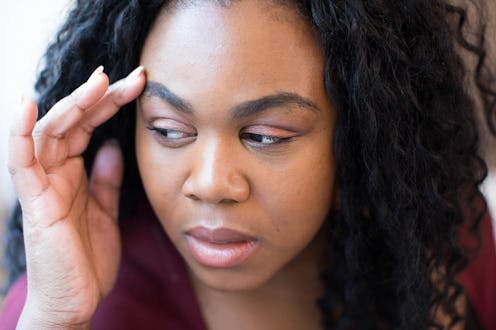Life
The Major Difference Between PMDD & Bipolar Disorder — And Why You Need To Know About It

You're not alone if you've never heard of premenstrual dysphoric disorder; it's one of the lesser-known conditions surrounding menstruation, and was only recently given its own entry in the Diagnostic & Statistical Manual, which defines how psychiatrists understand and treat mental disorders. But the condition is often misdiagnosed as bipolar disorder, if it's ever diagnosed at all, leading to confusion on how to treat it — the two disorders are very different, though both affect mood, and it's important to know the difference between them.
According to scientists at the period-tracking app Clue, premenstrual dysphoric disorder "differs from other psychiatric conditions, such as generalized anxiety disorder, in that symptoms are linked directly to the fluctuations of reproductive hormones, and a diagnosis usually requires that people experience these symptoms predominantly during the late luteal phase." This means that PMDD, as it's called, is occasionally described as a "severe" form of PMS, but that's not exactly accurate.
According to Dr. Marsha Tanenberg-Karant, a psychiatrist in New York, there are distinct differences if you know what to look for. "PMDD," she tells Bustle, "can be thought of as a mood disorder that develops within the week before the onset of monthly menses and disappears within the week following menses. These are sharp time boundaries. The symptoms have to cause clinically significant distress or interfere with your usual activities." One of the main differences, she says, is the timing. PMDD mood fluctuations and depressive symptoms are "by definition not present outside this time frame during the menstrual cycle, while bipolar affective disorder types I and II are not time-limited the way PMDD is time-limited. Periods of depression and/or what is known as hypomania are not restricted to the weeks surrounding menses."
According to the Oxford Handbook of Mood Disorders, there are eleven collective symptoms that distinguish PMDD from other conditions, and they're intense even on their own: depressed mood, anxiety or tension, mood swings, anger or irritability, decreased interest, concentration difficulties, fatigue, feeling overwhelmed, appetite changes or food cravings, sleep disturbances, and physical symptoms. Dr. Tanenberg-Karant tells Bustle that typical physical symptoms include bloating and breast tenderness. The main distinguishing factor of PMDD is that these symptoms must appear or get significantly worse in the days or weeks preceding your period, to the extent that they resemble a depressive "episode."
It's estimated that 3 to 9 percent of all women experience some form of PMDD during their reproductive years, which is a whopping number considering how few people actually know about it. And the problem of misdiagnosis is a real one. PMDD is often characterized as bipolar disorder II because the sudden dips in mood, tied to the luteal phase, look a lot like bipolar depression.
PMDD also doesn't involve the more elevated moods that characterize bipolar disorders I and II: mania and hypomania. "Mania or a more minor mania known as hypomania," Dr. Tanenberg-Karant tells Bustle, involve "symptoms of sleeplessness, high energy and/or possible distractibility, grandiosity, racing thoughts, increased activity and speaking as well as recklessness — financial, sexual, speeding excesses, for example — and may even present with delusional thoughts or hallucinations." PMDD has none of these symptoms.
Part of the misdiagnosis problem, some scientists believe, is down to women dismissing their own symptoms. Commonly, women with PMDD and PMS issues don't seek help until they're in their thirties, even if they've been experiencing the issues since they hit puberty. Bipolar symptoms often show up in women in their thirties too, so that may create confusion. But there's something else that complicates matters: for women who do have bipolar II, symptoms do in fact get worse in the weeks before menstruation, because of the influence of hormones on mood. You can't use menstrual cycles to tell PMDD and bipolar II apart. It's not surprising that doctors — and patients — get confused.
The relationship between bipolar disorders and PMDD isn't just one of diagnostic confusion, either. Studies have shown that having bipolar disorder II raises your risk of developing PMDD too, as does experiencing post-partum depression. We're not sure why this overlap exists. But there are a lot of problems that can result from mistaking one disorder for the other, not least because you can treat them with very different things.
"Treatment options for PMDD," Clue scientists tell Bustle, "are limited to drugs that either change hormone release, such as ovulation inhibitors, or treat symptoms, such as antidepressants." And there's been some evidence that it's actually possible to treat PMDD with a mild oral contraceptive, and that women with PMDD respond best to a course of antidepressants that focus on serotonin levels, AKA SSRIs. That's an issue, because SSRIs are a bit controversial when it comes to bipolar II treatment. Doctors are often hesitant to prescribe them to bipolar patients because they can induce something called "rapid cycling": a phenomenon where people with bipolar disorder go through "waves" of up and down much faster than normal, which is very dangerous. If a doctor mistakes PMDD for bipolar, they might avoid prescribing the antidepressants that could actually really help.
If you do notice any depressive dips in your mood, whether not they're tied to your menstrual cycle, Dr. Tanenberg-Karant emphasizes that you need to get help. "Depression can be a very serious syndrome and have implications for all parts of your life," she tells Bustle. "Please take your research or listen to your loved ones and consult someone with expertise in diagnosis and treatment." And if you've noticed that the problems seem to pop up only in the late luteal phase before your period, it's worth flagging that to your doctor.